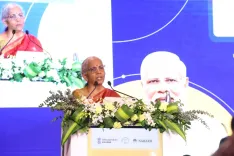Is Masood Azhar in Hiding? JeM Cadres Consider Defection Despite AI Propaganda Efforts

Synopsis
Key Takeaways
- Masood Azhar is in hiding, causing unrest within JeM.
- Operation Sindoor led to significant losses for the JeM.
- JeM is attempting to maintain morale through propaganda efforts.
- Loss of key leadership has left the group vulnerable.
- The ISI is concerned about potential defections within JeM.
New Delhi, Oct 15 (NationPress) Masood Azhar, the leader of Jaish-e-Mohammad, has effectively retreated into hiding following Operation Sindoor. The truth is well established that his organization was severely weakened by the Indian armed forces.
A commander from the JeM confirmed that Azhar's family suffered significant losses during the operation executed in retaliation for the Pahalgam attack.
Indian intelligence reports indicate that Azhar remains concealed and has been cautioned against making any public appearances.
The Indian armed forces are keeping a vigilant watch over him, and the Pakistan Army is taking no risks, ensuring he remains under strict surveillance.
Azhar's prolonged silence is causing unrest among JeM fighters, with many feeling disheartened due to the lack of leadership.
Historically, when Azhar would go into hiding or seek medical attention, his brother Rauf Azghar would take command.
Azghar was pivotal in JeM operations, serving as an effective second-in-command to his brother Azhar. His death at Bahawalpur during Operation Sindoor was a significant blow for the JeM, stripping them of their operational leader.
Azhar, primarily an ideological figure, has left the organization in disarray, leading to diminishing faith among the fighters.
To maintain the flow of information and instill hope among the cadres, JeM has announced the establishment of new wings.
Recently, it was revealed that the group is launching a women's division. Intelligence officials suggest that the JeM will require time to recuperate. Additionally, they are conscious that any aggressive action against India would elicit a strong response. Consequently, they are not in a position to take chances and continue to circulate news about new initiatives to lift the morale of their fighters.
With the JeM weakened and leadership absent, Indian agencies caution that while the group may refrain from direct actions, it could enhance the dissemination of propaganda videos.
Reports indicate that these videos are proliferating not only in Pakistan but also in various regions of India.
The group is utilizing Artificial Intelligence (AI) to produce and disseminate videos, including images of Azhar.
The cadres are being led to believe that their chief is well, encouraging them to maintain high morale.
Officials warn that while such propaganda might have temporary effects, it is ultimately short-lived.
The JeM operatives are eager to launch attacks in Jammu and Kashmir, and prolonged restrictions may lead them to question the changes. The ISI faces challenges in containing these elements. Furthermore, there is discontent among JeM members regarding the evolving relations with the Taliban.
The JeM has historically supported the Taliban but must now remain silent as the current Pakistani establishment stands against the Afghan Taliban.
JeM leadership has consistently believed in the unity of all radical Islamic factions, directing their conflict towards India and the West. However, the current political landscape in Pakistan, marked by ineffective leadership, has drastically shifted. The establishment is now embroiled in conflicts with groups such as the Tehreek-e-Taliban Pakistan (TTP), Balochistan Liberation Army (BLA), and the Afghan Taliban.
Many within the JeM are dissatisfied with the prevailing circumstances, and the ISI fears potential defections. The only method for the ISI to stabilize or uplift the cadres may be to orchestrate a significant attack on India. However, this remains a risky strategy, as the Indian government, with its new doctrine, will not overlook such provocations.









